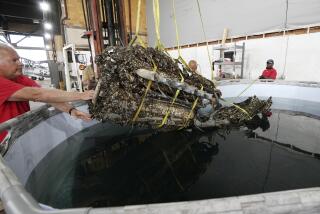Effort to Retrieve Vintage Spy Plane Is Stymied : Military: Bad weather, illness conspire against group’s plan to salvage B-29. The Kee Bird crashed in Greenland in 1947 while on a reconnaissance mission.
- Share via
SAN DIEGO — Bad weather and illness among crew members have forced suspension of efforts to retrieve a B-29 from the arctic wastes of Greenland until spring.
*
The Air Force has been providing logistic support to a private group trying to retrieve the B-29 nicknamed the Kee Bird. The big bomber crash-landed on a frozen lake while on a spy mission Feb. 21, 1947.
“That bird has been there for 47 years, it can wait a few more months,” Air Force spokesman Tech. Sgt. Scott Milne said Thursday.
As part of the top-secret Project Nanook, the Kee Bird was looking for evidence that the Soviet Union was building military bases north of the Arctic Circle. The plane became lost and ended up landing 1,000 miles off course; after three days, all 11 crew members were rescued.
The delay in retrieving the Kee Bird, although disappointing to those who have struggled against bitter cold and driving rain, does not surprise aviation observers who have followed similar efforts.
Wayman Dunlap, editor of Oceanside-based Pacific Flyer Aviation News, said retrieval missions routinely take much longer and cost much more than the organizers estimate.
“When you’re trying to get one of these war birds out of a remote location, the rule is to figure out how long it will take, then double that amount of time and that’s still not long enough,” Dunlap said. “The same is true with money. Take all the money you can get, double it and it’s still only half enough.”
Milne said the retrieval team, headed by Orange County businessman and former Army pilot Tom Hess and retired Lockheed test pilot Darryl Greenamyer, succeeded in replacing the Kee Bird’s four engines and putting the plane in running order before the chief mechanic was stricken with a bleeding ulcer and an early winter storm dropped eight inches of snow on the makeshift runway.
“They could get the plane started fine, but they couldn’t get it off the ground because of the lack of a decent runway,” Milne said.
The team plans to return next spring when the arctic weather eases and temperatures again creep above freezing.
Using Thule Air Force Base as a staging ground, the retrieval team has been ferrying supplies 250 miles north to the crash site in an aging Army transport, a C-7 Caribou. The Caribou, owned by Greenamyer, is built for short landings and takeoffs, but the B-29 requires a 4,000-foot-long runway for safety.
The plan had been to fly the Kee Bird to Thule for additional repairs and then fly it to the United States in time for the Reno National Championship Air Races in September.
The possible return of the Kee Bird had caused considerable interest in aviation circles.
Of 4,000 B-29 Superfortresses built during World War II, only one is still flying. That plane, rescued from the Naval Weapons Center at China Lake in the Mojave Desert, is called Fifi and is the possession of the Texas-based Confederate Air Force, a private group dedicated to the restoration of World War II aircraft.
Given the Kee Bird’s colorful history, and the general clamor for restored aircraft, aviation observers expect that Hess and Greenamyer, who both live in Rancho Santa Fe, will have no trouble selling the plane for a profit.
Dunlap said that after he was quoted in a newspaper story about the Kee Bird, he received a call from an agent for a moneyed businessman willing to pay $1 million for the plane sight unseen.
The Kee Bird, flying out of Ladd Field in Fairbanks, Alaska, became lost when bad weather engulfed the plane and prevented navigators from seeing enough stars to determine their location. As it ran out of fuel, the pilot landed on frozen land with only minimal damage to the aircraft.
Three days later, the 11 crew members were brought to safety in a rescue effort so daring it earned the rescue crew a trip to the White House to receive congratulations from President Harry S. Truman.
Kee Bird crewmen were warned never to reveal the nature of their mission. The commander of Project Nanook ordered that the Kee Bird be bombed to prevent it from falling into Soviet hands, but the order was never carried out.
More to Read
Sign up for Essential California
The most important California stories and recommendations in your inbox every morning.
You may occasionally receive promotional content from the Los Angeles Times.










